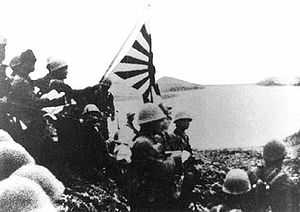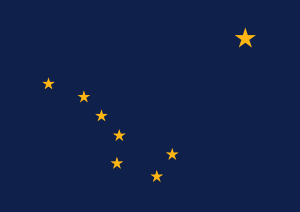Japanese occupation of Kiska
| ||||||||||||||||||||||||||||||
| ||||||||||||||||||||||||||||||
The Japanese occupation of Kiska took place between 6 June 1942 and 28 July 1943 during the Aleutian Islands Campaign of the American Theater and the Pacific Theater of World War II. The Japanese occupied Kiska and nearby Attu Island in order to protect the northern flank of the Japanese Empire.
Occupation
Initially, the only American military presence on Kiska was a twelve-man United States Navy weather station, two of whom were not present during the invasion.[4] The Japanese stormed the station, killing two Americans and capturing seven. After realizing that a Chief petty officer had escaped, a search was launched by the occupying forces. The search ended in vain, with the escapee surrendering some fifty days after the initial seizure of the weather station, having been unable too cope with the freezing conditions & starvation.[5] Beforehand, the prisoners of war had been sent to Japan.
The attack on Pearl Harbor and beginning of the Pacific Theater in World War II, coupled with Japanese threats to the west coast of North America and the Aleutian Islands, had already made the construction of a defense access highway to Alaska a priority. On 6 February 1942, the construction of the Alaska Highway was approved by the U.S. Army and the project received the authorization from the U.S. Congress and President Franklin D. Roosevelt to proceed five days later.
Reacting to the Japanese occupation, American and Canadian air forces waged a continuous air bombardment campaign against the Japanese forces on Kiska. Also, U.S. Navy warships blockaded and periodically bombarded the island. Several Japanese warships, transport ships, and submarines attempting to travel to Kiska or Attu were sunk or damaged by the blockading forces.
In 1943, U.S. forces landed on and destroyed the Japanese garrison on Attu. In response, the Imperial Japanese Navy successfully evacuated the Kiska garrison on 28 July, ending the Japanese presence in the Aleutian Islands. Not completely sure that the Japanese were gone, the Americans and Canadians executed an unopposed landing on Kiska on 15 August, securing the island and ending the Aleutian Islands campaign.
Naval operations
On 19 June 1942, American aircraft attacked and sank the Japanese oiler Nissan Maru in Kiska Harbor and on 30 June American naval forces bombarded the island. The American submarine USS Growler attacked and sank one Japanese destroyer 7 mi (6.1 nmi; 11 km) east of Kiska Harbor on 5 July, two other destroyers were also heavily damaged. Over 200 Japanese sailors were killed or wounded while the Americans sustained no losses, it became the single bloodiest engagement during the operations on and around Kiska. USS Grunion was attacked by three Japanese submarine chasers while patrolling Kiska Harbor on 15 July. In response, she fired on and sank two of the Japanese ships and damaged the third. Grunion was lost a few weeks later off Kiska on 30 July with all hands, she is suspected of being sunk after one of her own torpedoes circled back when she attacked the Kano Maru.
On 8 August, the Japanese cargo ship Kano Maru was sunk at Kiska Harbor by PBY Catalinas. Days before, the cargo ship was damaged by one of Grunion 's torpedoes. Troopship Nozima Maru was also bombed and sunk in Kiska Harbor on 15 September. On 5 October, the Japanese steamer Borneo Maru was sunk at Gertrude Cove and on 17 https://en.wikipedia.org/wiki/Japanese_occupation_of_KiskaOctober, the destroyer Oboro was sunk by American aircraft. RO-65 sank off Kiska on 4 November, Montreal Maru on 5 January 1943, and Uragio Maru on 4 April. I-7 was grounded and abandoned by her crew on 23 June while assisting in removing Kiska's garrison. She was chased onto the rocks by USS Monaghan.
See also
References
Notes
- ↑ http://www.hlswilliwaw.com/aleutians/Aleutians/html/wwii_kiska_navy_crew_listing.htm
- ↑ http://www.hlswilliwaw.com/aleutians/Aleutians/html/wwii_kiska_navy_crew_listing.htm
- ↑ http://www.pacificwrecks.com/provinces/alaska_kiska.html
- ↑ http://www.hlswilliwaw.com/aleutians/Aleutians/html/wwii_kiska_navy_crew_listing.htm
- ↑ http://www.pacificwrecks.com/provinces/alaska_kiska
Bibliography
- Cloe, John Haile (1990). The Aleutian Warriors: A History of the 11th Air Force and Fleet Air Wing 4. Missoula, Montana: Pictorial Histories Publishing Co. and Anchorage Chapter – Air Force Association. ISBN 0-929521-35-8. OCLC 25370916.
- Dickrell, Jeff (2001). Center of the Storm: The Bombing of Dutch Harbor and the Experience of Patrol Wing Four in the Aleutians, Summer 1942. Missoula, Montana: Pictorial Histories Publishing Co., Inc. ISBN 1-57510-092-4. OCLC 50242148.
- Feinberg, Leonard (1992). Where the Williwaw Blows: The Aleutian Islands-World War II. Pilgrims' Process. ISBN 0-9710609-8-3. OCLC 57146667.
- Garfield, Brian (1995) [1969]. The Thousand-Mile War: World War II in Alaska and the Aleutians. Fairbanks: University of Alaska Press. ISBN 0-912006-83-8. OCLC 33358488.
- Goldstein, Donald M.; Katherine V. Dillon (1992). The Williwaw War: The Arkansas National Guard in the Aleutians in World War. Fayettville: University of Arkansas Press. ISBN 1-55728-242-0. OCLC 24912734.
- Hays, Otis (2004). Alaska's Hidden Wars: Secret Campaigns on the North Pacific Rim. University of Alaska Press. ISBN 1-889963-64-X.
- Lorelli, John A. (1984). The Battle of the Komandorski Islands. Annapolis: United States Naval Institute. ISBN 0-87021-093-9. OCLC 10824413.
- Morison, Samuel Eliot (2001) [1951]. Aleutians, Gilberts and Marshalls, June 1942-April 1944, vol. 7 of History of United States Naval Operations in World War II. Champaign: University of Illinois Press. ISBN 0-316-58305-7. OCLC 7288530.
- Parshall, Jonathan; Tully, Anthony (2005). Shattered Sword: The Untold Story of the Battle of Midway. Dulles, Virginia: Potomac Books. ISBN 1-57488-923-0. OCLC 60373935.
- Perras, Galen Roger (2003). Stepping Stones to Nowhere, The Aleutian Islands, Alaska, and American Military Strategy, 1867 - 1945. Vancouver: University of British Columbia Press. ISBN 1-59114-836-7. OCLC 53015264.
- Urwin, Gregory J. W. (2000). The Capture of Attu: A World War II Battle as Told by the Men Who Fought There. Bison Books. ISBN 0-8032-9557-X.
- Wetterhahn, Ralph (2004). The Last Flight of Bomber 31: Harrowing Tales of American and Japanese Pilots Who Fought World War II's Arctic Air Campaign. Da Capo Press. ISBN 0-7867-1360-7.
- Aleutian Islands. The U.S. Army Campaigns of World War II. United States Army Center of Military History. CMH Pub 72-6.
|first1=missing|last1=in Authors list (help)
External links
| Wikimedia Commons has media related to Japanese occupation of Kiska. |
- Logistics Problems on Attu by Robert E. Burks.
- Aleutian Islands Chronology
- Aleutian Islands War
- Red White Black & Blue - feature documentary about The Battle of Attu in the Aleutians during World War II
- PBS Independent Lens presentation of Red White Black & Blue - The Making Of and other resources
- Soldiers of the 184th Infantry, 7th ID in the Pacific, 1943-1945


